Annotated Bibliographies on Hydraulic Fracturing for Natural Gas
VerifiedAdded on 2023/06/04
|7
|1372
|175
AI Summary
This annotated bibliography provides a comprehensive review of the legal, environmental, and economic issues related to hydraulic fracturing for natural gas. The sources cover topics such as the impact on biodiversity, carbon footprint analysis, and chemical disclosure requirements.
Contribute Materials
Your contribution can guide someone’s learning journey. Share your
documents today.
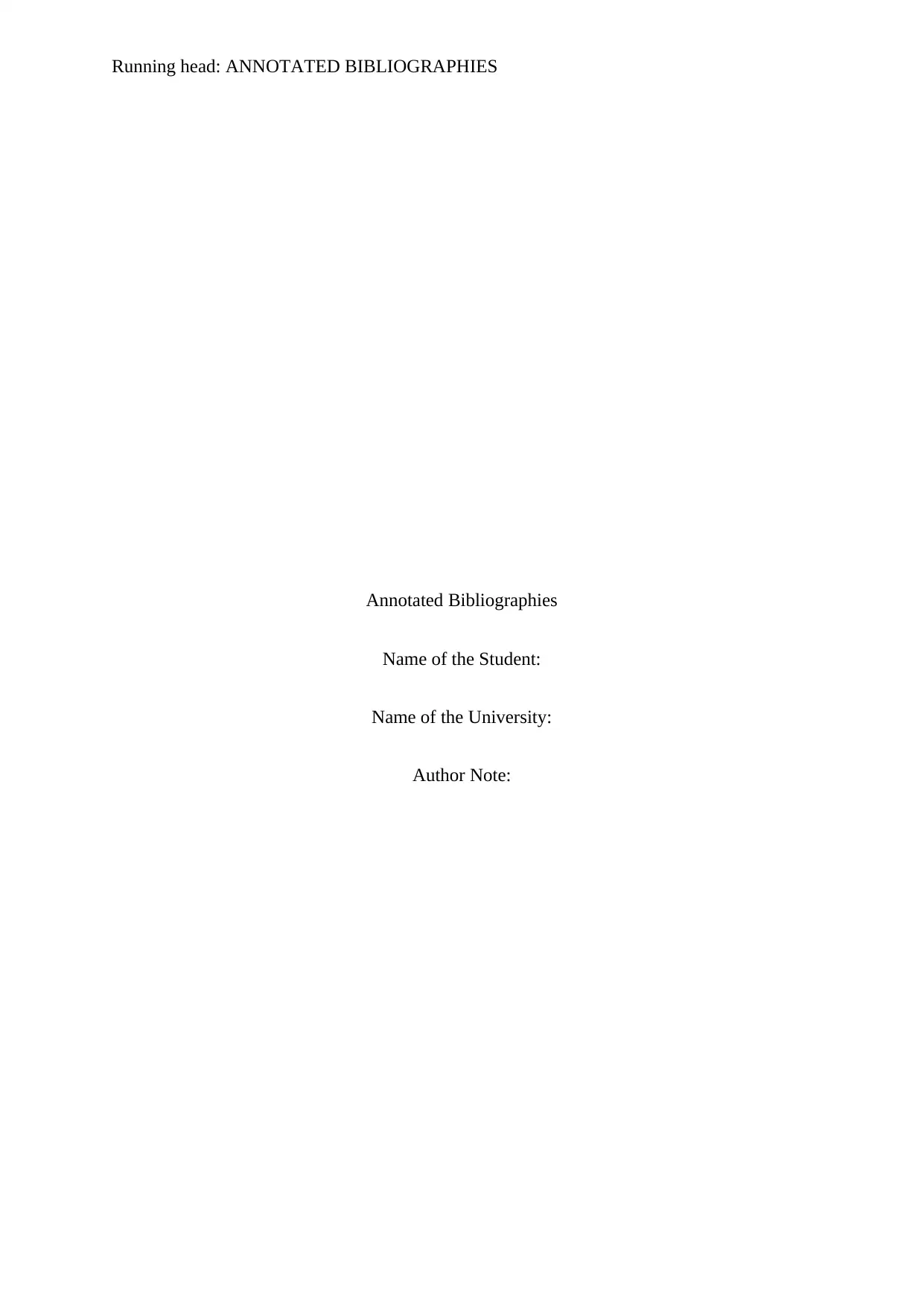
Running head: ANNOTATED BIBLIOGRAPHIES
Annotated Bibliographies
Name of the Student:
Name of the University:
Author Note:
Annotated Bibliographies
Name of the Student:
Name of the University:
Author Note:
Secure Best Marks with AI Grader
Need help grading? Try our AI Grader for instant feedback on your assignments.
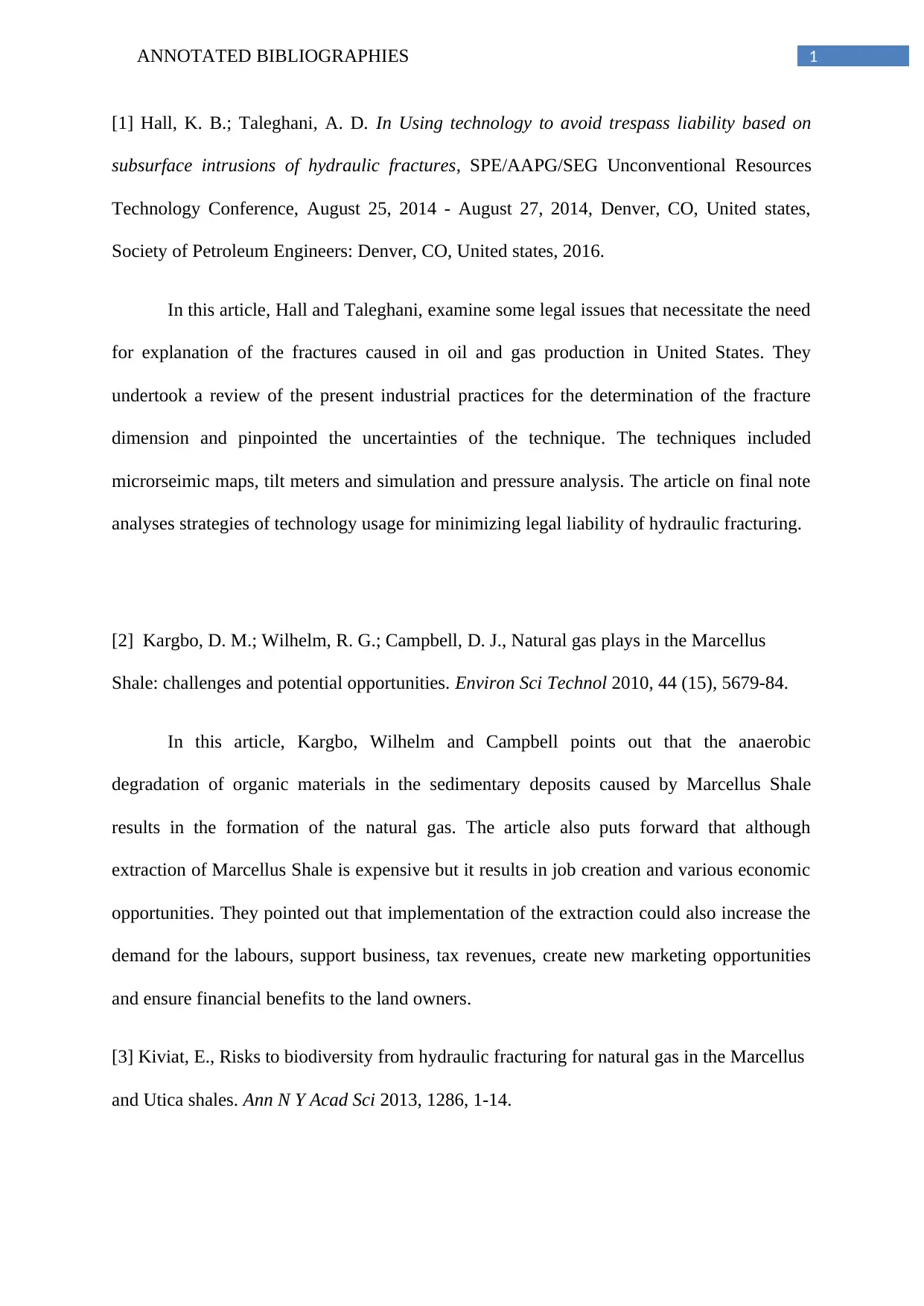
1ANNOTATED BIBLIOGRAPHIES
[1] Hall, K. B.; Taleghani, A. D. In Using technology to avoid trespass liability based on
subsurface intrusions of hydraulic fractures, SPE/AAPG/SEG Unconventional Resources
Technology Conference, August 25, 2014 - August 27, 2014, Denver, CO, United states,
Society of Petroleum Engineers: Denver, CO, United states, 2016.
In this article, Hall and Taleghani, examine some legal issues that necessitate the need
for explanation of the fractures caused in oil and gas production in United States. They
undertook a review of the present industrial practices for the determination of the fracture
dimension and pinpointed the uncertainties of the technique. The techniques included
microrseimic maps, tilt meters and simulation and pressure analysis. The article on final note
analyses strategies of technology usage for minimizing legal liability of hydraulic fracturing.
[2] Kargbo, D. M.; Wilhelm, R. G.; Campbell, D. J., Natural gas plays in the Marcellus
Shale: challenges and potential opportunities. Environ Sci Technol 2010, 44 (15), 5679-84.
In this article, Kargbo, Wilhelm and Campbell points out that the anaerobic
degradation of organic materials in the sedimentary deposits caused by Marcellus Shale
results in the formation of the natural gas. The article also puts forward that although
extraction of Marcellus Shale is expensive but it results in job creation and various economic
opportunities. They pointed out that implementation of the extraction could also increase the
demand for the labours, support business, tax revenues, create new marketing opportunities
and ensure financial benefits to the land owners.
[3] Kiviat, E., Risks to biodiversity from hydraulic fracturing for natural gas in the Marcellus
and Utica shales. Ann N Y Acad Sci 2013, 1286, 1-14.
[1] Hall, K. B.; Taleghani, A. D. In Using technology to avoid trespass liability based on
subsurface intrusions of hydraulic fractures, SPE/AAPG/SEG Unconventional Resources
Technology Conference, August 25, 2014 - August 27, 2014, Denver, CO, United states,
Society of Petroleum Engineers: Denver, CO, United states, 2016.
In this article, Hall and Taleghani, examine some legal issues that necessitate the need
for explanation of the fractures caused in oil and gas production in United States. They
undertook a review of the present industrial practices for the determination of the fracture
dimension and pinpointed the uncertainties of the technique. The techniques included
microrseimic maps, tilt meters and simulation and pressure analysis. The article on final note
analyses strategies of technology usage for minimizing legal liability of hydraulic fracturing.
[2] Kargbo, D. M.; Wilhelm, R. G.; Campbell, D. J., Natural gas plays in the Marcellus
Shale: challenges and potential opportunities. Environ Sci Technol 2010, 44 (15), 5679-84.
In this article, Kargbo, Wilhelm and Campbell points out that the anaerobic
degradation of organic materials in the sedimentary deposits caused by Marcellus Shale
results in the formation of the natural gas. The article also puts forward that although
extraction of Marcellus Shale is expensive but it results in job creation and various economic
opportunities. They pointed out that implementation of the extraction could also increase the
demand for the labours, support business, tax revenues, create new marketing opportunities
and ensure financial benefits to the land owners.
[3] Kiviat, E., Risks to biodiversity from hydraulic fracturing for natural gas in the Marcellus
and Utica shales. Ann N Y Acad Sci 2013, 1286, 1-14.
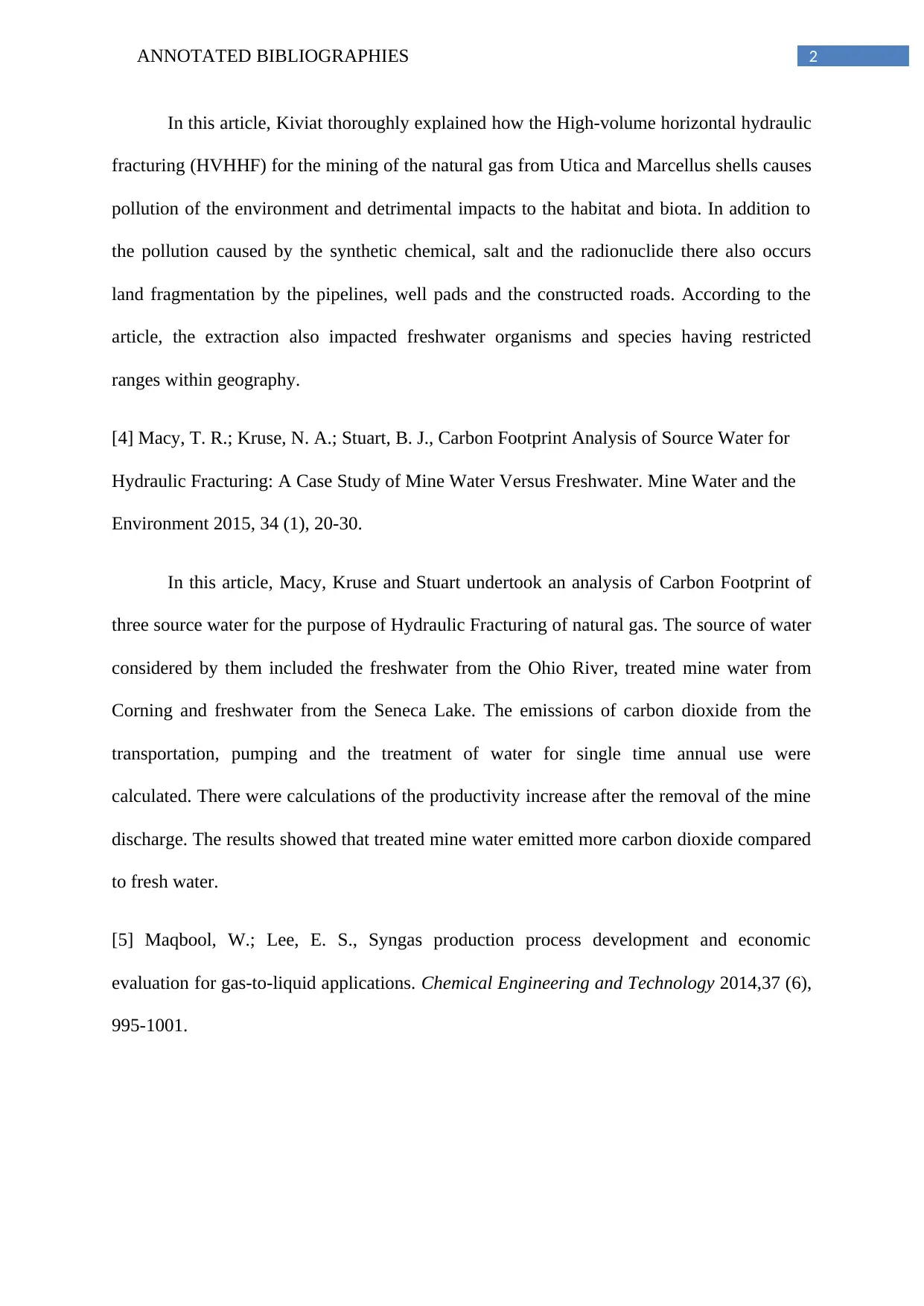
2ANNOTATED BIBLIOGRAPHIES
In this article, Kiviat thoroughly explained how the High-volume horizontal hydraulic
fracturing (HVHHF) for the mining of the natural gas from Utica and Marcellus shells causes
pollution of the environment and detrimental impacts to the habitat and biota. In addition to
the pollution caused by the synthetic chemical, salt and the radionuclide there also occurs
land fragmentation by the pipelines, well pads and the constructed roads. According to the
article, the extraction also impacted freshwater organisms and species having restricted
ranges within geography.
[4] Macy, T. R.; Kruse, N. A.; Stuart, B. J., Carbon Footprint Analysis of Source Water for
Hydraulic Fracturing: A Case Study of Mine Water Versus Freshwater. Mine Water and the
Environment 2015, 34 (1), 20-30.
In this article, Macy, Kruse and Stuart undertook an analysis of Carbon Footprint of
three source water for the purpose of Hydraulic Fracturing of natural gas. The source of water
considered by them included the freshwater from the Ohio River, treated mine water from
Corning and freshwater from the Seneca Lake. The emissions of carbon dioxide from the
transportation, pumping and the treatment of water for single time annual use were
calculated. There were calculations of the productivity increase after the removal of the mine
discharge. The results showed that treated mine water emitted more carbon dioxide compared
to fresh water.
[5] Maqbool, W.; Lee, E. S., Syngas production process development and economic
evaluation for gas-to-liquid applications. Chemical Engineering and Technology 2014,37 (6),
995-1001.
In this article, Kiviat thoroughly explained how the High-volume horizontal hydraulic
fracturing (HVHHF) for the mining of the natural gas from Utica and Marcellus shells causes
pollution of the environment and detrimental impacts to the habitat and biota. In addition to
the pollution caused by the synthetic chemical, salt and the radionuclide there also occurs
land fragmentation by the pipelines, well pads and the constructed roads. According to the
article, the extraction also impacted freshwater organisms and species having restricted
ranges within geography.
[4] Macy, T. R.; Kruse, N. A.; Stuart, B. J., Carbon Footprint Analysis of Source Water for
Hydraulic Fracturing: A Case Study of Mine Water Versus Freshwater. Mine Water and the
Environment 2015, 34 (1), 20-30.
In this article, Macy, Kruse and Stuart undertook an analysis of Carbon Footprint of
three source water for the purpose of Hydraulic Fracturing of natural gas. The source of water
considered by them included the freshwater from the Ohio River, treated mine water from
Corning and freshwater from the Seneca Lake. The emissions of carbon dioxide from the
transportation, pumping and the treatment of water for single time annual use were
calculated. There were calculations of the productivity increase after the removal of the mine
discharge. The results showed that treated mine water emitted more carbon dioxide compared
to fresh water.
[5] Maqbool, W.; Lee, E. S., Syngas production process development and economic
evaluation for gas-to-liquid applications. Chemical Engineering and Technology 2014,37 (6),
995-1001.
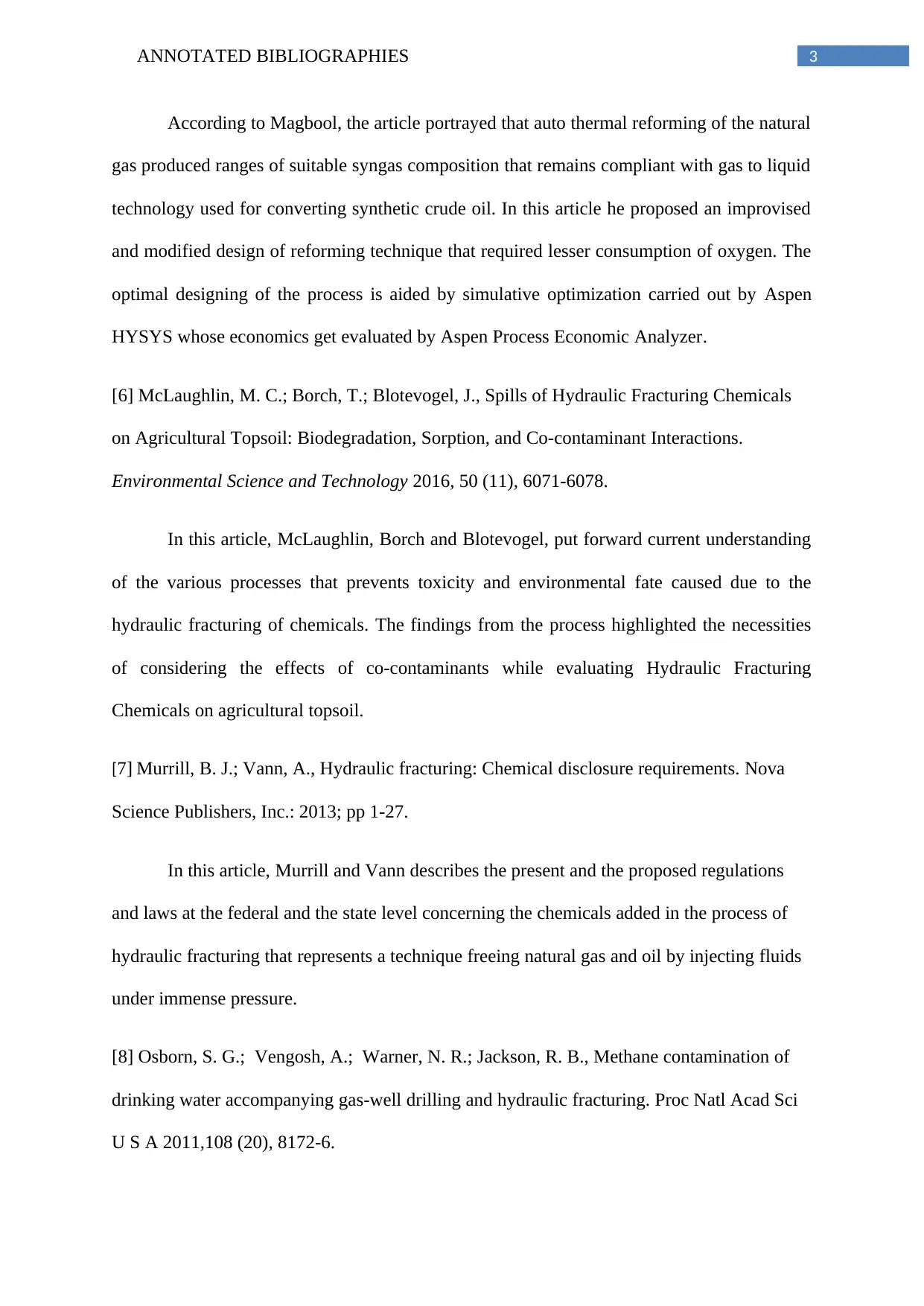
3ANNOTATED BIBLIOGRAPHIES
According to Magbool, the article portrayed that auto thermal reforming of the natural
gas produced ranges of suitable syngas composition that remains compliant with gas to liquid
technology used for converting synthetic crude oil. In this article he proposed an improvised
and modified design of reforming technique that required lesser consumption of oxygen. The
optimal designing of the process is aided by simulative optimization carried out by Aspen
HYSYS whose economics get evaluated by Aspen Process Economic Analyzer.
[6] McLaughlin, M. C.; Borch, T.; Blotevogel, J., Spills of Hydraulic Fracturing Chemicals
on Agricultural Topsoil: Biodegradation, Sorption, and Co-contaminant Interactions.
Environmental Science and Technology 2016, 50 (11), 6071-6078.
In this article, McLaughlin, Borch and Blotevogel, put forward current understanding
of the various processes that prevents toxicity and environmental fate caused due to the
hydraulic fracturing of chemicals. The findings from the process highlighted the necessities
of considering the effects of co-contaminants while evaluating Hydraulic Fracturing
Chemicals on agricultural topsoil.
[7] Murrill, B. J.; Vann, A., Hydraulic fracturing: Chemical disclosure requirements. Nova
Science Publishers, Inc.: 2013; pp 1-27.
In this article, Murrill and Vann describes the present and the proposed regulations
and laws at the federal and the state level concerning the chemicals added in the process of
hydraulic fracturing that represents a technique freeing natural gas and oil by injecting fluids
under immense pressure.
[8] Osborn, S. G.; Vengosh, A.; Warner, N. R.; Jackson, R. B., Methane contamination of
drinking water accompanying gas-well drilling and hydraulic fracturing. Proc Natl Acad Sci
U S A 2011,108 (20), 8172-6.
According to Magbool, the article portrayed that auto thermal reforming of the natural
gas produced ranges of suitable syngas composition that remains compliant with gas to liquid
technology used for converting synthetic crude oil. In this article he proposed an improvised
and modified design of reforming technique that required lesser consumption of oxygen. The
optimal designing of the process is aided by simulative optimization carried out by Aspen
HYSYS whose economics get evaluated by Aspen Process Economic Analyzer.
[6] McLaughlin, M. C.; Borch, T.; Blotevogel, J., Spills of Hydraulic Fracturing Chemicals
on Agricultural Topsoil: Biodegradation, Sorption, and Co-contaminant Interactions.
Environmental Science and Technology 2016, 50 (11), 6071-6078.
In this article, McLaughlin, Borch and Blotevogel, put forward current understanding
of the various processes that prevents toxicity and environmental fate caused due to the
hydraulic fracturing of chemicals. The findings from the process highlighted the necessities
of considering the effects of co-contaminants while evaluating Hydraulic Fracturing
Chemicals on agricultural topsoil.
[7] Murrill, B. J.; Vann, A., Hydraulic fracturing: Chemical disclosure requirements. Nova
Science Publishers, Inc.: 2013; pp 1-27.
In this article, Murrill and Vann describes the present and the proposed regulations
and laws at the federal and the state level concerning the chemicals added in the process of
hydraulic fracturing that represents a technique freeing natural gas and oil by injecting fluids
under immense pressure.
[8] Osborn, S. G.; Vengosh, A.; Warner, N. R.; Jackson, R. B., Methane contamination of
drinking water accompanying gas-well drilling and hydraulic fracturing. Proc Natl Acad Sci
U S A 2011,108 (20), 8172-6.
Secure Best Marks with AI Grader
Need help grading? Try our AI Grader for instant feedback on your assignments.

4ANNOTATED BIBLIOGRAPHIES
In this article, Osborn, Venghosh, Warner and Jackson documented that the Shale gas
extraction led to methane contamination of the drinking water. They found that the
concentration of methane in drinking water is directly to the proximity of gas well. They also
pointed that to ensure sustainable future of the extraction process regulation was necessary.
In this article, Osborn, Venghosh, Warner and Jackson documented that the Shale gas
extraction led to methane contamination of the drinking water. They found that the
concentration of methane in drinking water is directly to the proximity of gas well. They also
pointed that to ensure sustainable future of the extraction process regulation was necessary.
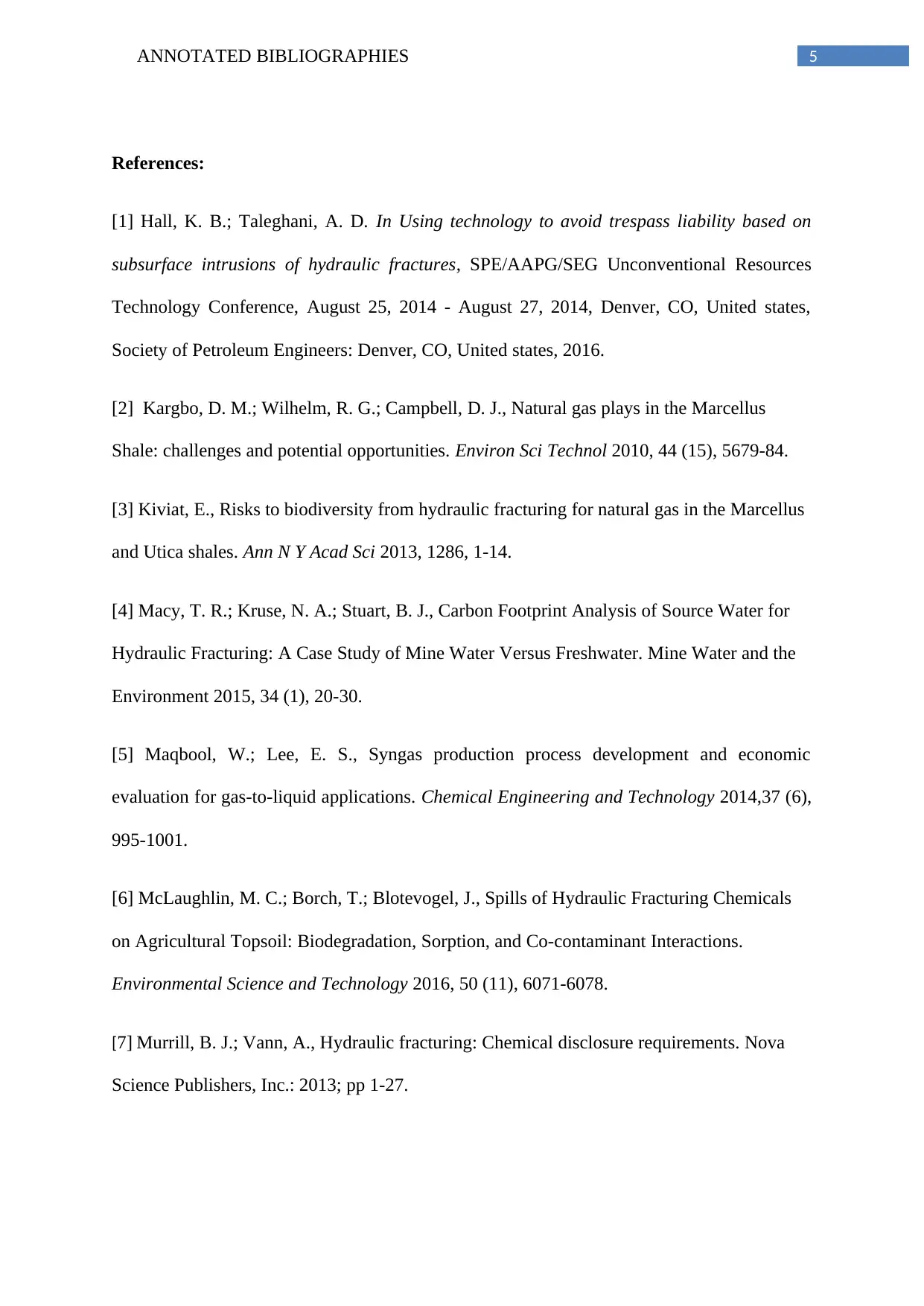
5ANNOTATED BIBLIOGRAPHIES
References:
[1] Hall, K. B.; Taleghani, A. D. In Using technology to avoid trespass liability based on
subsurface intrusions of hydraulic fractures, SPE/AAPG/SEG Unconventional Resources
Technology Conference, August 25, 2014 - August 27, 2014, Denver, CO, United states,
Society of Petroleum Engineers: Denver, CO, United states, 2016.
[2] Kargbo, D. M.; Wilhelm, R. G.; Campbell, D. J., Natural gas plays in the Marcellus
Shale: challenges and potential opportunities. Environ Sci Technol 2010, 44 (15), 5679-84.
[3] Kiviat, E., Risks to biodiversity from hydraulic fracturing for natural gas in the Marcellus
and Utica shales. Ann N Y Acad Sci 2013, 1286, 1-14.
[4] Macy, T. R.; Kruse, N. A.; Stuart, B. J., Carbon Footprint Analysis of Source Water for
Hydraulic Fracturing: A Case Study of Mine Water Versus Freshwater. Mine Water and the
Environment 2015, 34 (1), 20-30.
[5] Maqbool, W.; Lee, E. S., Syngas production process development and economic
evaluation for gas-to-liquid applications. Chemical Engineering and Technology 2014,37 (6),
995-1001.
[6] McLaughlin, M. C.; Borch, T.; Blotevogel, J., Spills of Hydraulic Fracturing Chemicals
on Agricultural Topsoil: Biodegradation, Sorption, and Co-contaminant Interactions.
Environmental Science and Technology 2016, 50 (11), 6071-6078.
[7] Murrill, B. J.; Vann, A., Hydraulic fracturing: Chemical disclosure requirements. Nova
Science Publishers, Inc.: 2013; pp 1-27.
References:
[1] Hall, K. B.; Taleghani, A. D. In Using technology to avoid trespass liability based on
subsurface intrusions of hydraulic fractures, SPE/AAPG/SEG Unconventional Resources
Technology Conference, August 25, 2014 - August 27, 2014, Denver, CO, United states,
Society of Petroleum Engineers: Denver, CO, United states, 2016.
[2] Kargbo, D. M.; Wilhelm, R. G.; Campbell, D. J., Natural gas plays in the Marcellus
Shale: challenges and potential opportunities. Environ Sci Technol 2010, 44 (15), 5679-84.
[3] Kiviat, E., Risks to biodiversity from hydraulic fracturing for natural gas in the Marcellus
and Utica shales. Ann N Y Acad Sci 2013, 1286, 1-14.
[4] Macy, T. R.; Kruse, N. A.; Stuart, B. J., Carbon Footprint Analysis of Source Water for
Hydraulic Fracturing: A Case Study of Mine Water Versus Freshwater. Mine Water and the
Environment 2015, 34 (1), 20-30.
[5] Maqbool, W.; Lee, E. S., Syngas production process development and economic
evaluation for gas-to-liquid applications. Chemical Engineering and Technology 2014,37 (6),
995-1001.
[6] McLaughlin, M. C.; Borch, T.; Blotevogel, J., Spills of Hydraulic Fracturing Chemicals
on Agricultural Topsoil: Biodegradation, Sorption, and Co-contaminant Interactions.
Environmental Science and Technology 2016, 50 (11), 6071-6078.
[7] Murrill, B. J.; Vann, A., Hydraulic fracturing: Chemical disclosure requirements. Nova
Science Publishers, Inc.: 2013; pp 1-27.
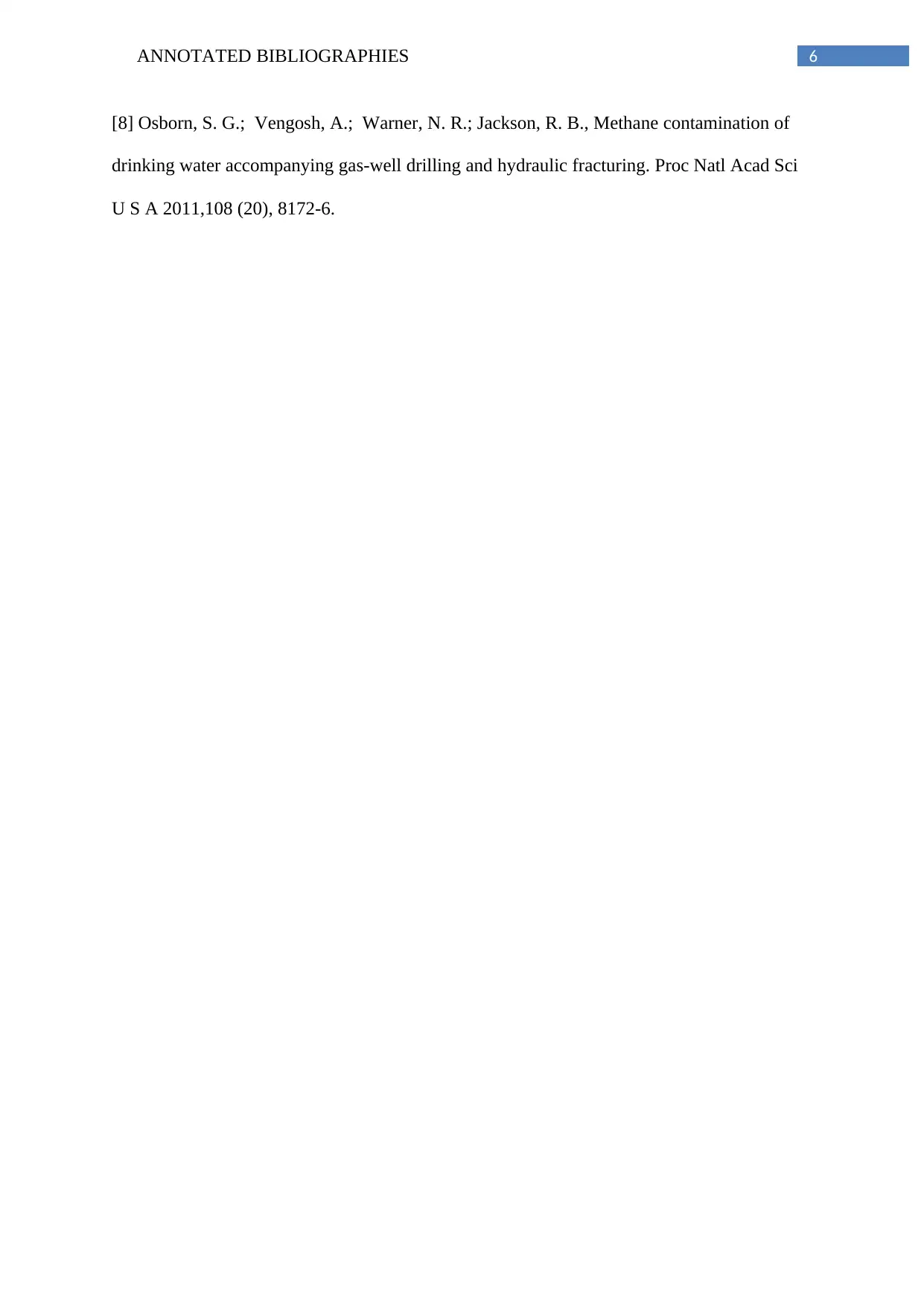
6ANNOTATED BIBLIOGRAPHIES
[8] Osborn, S. G.; Vengosh, A.; Warner, N. R.; Jackson, R. B., Methane contamination of
drinking water accompanying gas-well drilling and hydraulic fracturing. Proc Natl Acad Sci
U S A 2011,108 (20), 8172-6.
[8] Osborn, S. G.; Vengosh, A.; Warner, N. R.; Jackson, R. B., Methane contamination of
drinking water accompanying gas-well drilling and hydraulic fracturing. Proc Natl Acad Sci
U S A 2011,108 (20), 8172-6.
1 out of 7
Your All-in-One AI-Powered Toolkit for Academic Success.
+13062052269
info@desklib.com
Available 24*7 on WhatsApp / Email
![[object Object]](/_next/static/media/star-bottom.7253800d.svg)
Unlock your academic potential
© 2024 | Zucol Services PVT LTD | All rights reserved.